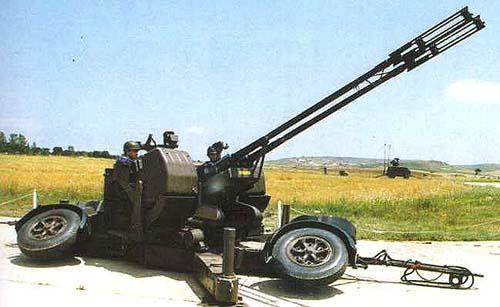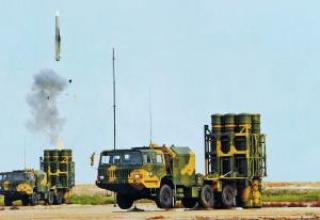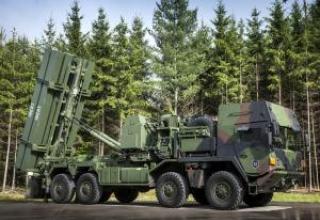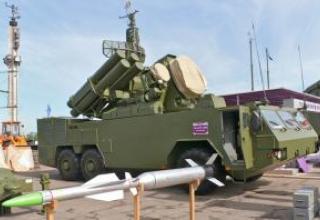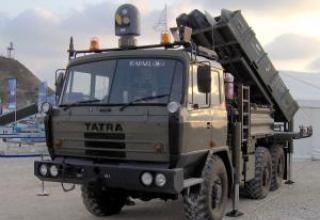In response to the growing importance of the detection and control of low-level air targets, a number of countries are developing radar tools to detect such targets in an effective and timely manner. In particular, the Swiss company Oerlikon Contraves Defence developed the all-weather fire control system Skyguard, originally designed for use with anti-aircraft systems (35 mm Oerlikon twin guns). At the same time, Swiss experts were considering the use of this system as part of an anti-aircraft missile system equipped with Sparrow missiles.
At present, the Skyguard system with missiles of various modifications is in service with the armies of Spain, Italy, Greece, Canada and other countries.
Composition:
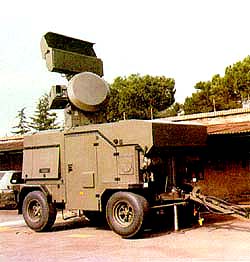
The Skyguard system can control fire from three launchers (four Sparrow Surface-to-Earth Containers each), or one PU and two 35mm Oerlikon guns. The latter option is considered by foreign experts to be the most appropriate for low-flying targets.
Fire control system "Skyguard" is located in a unified cabin, mounted on a two-axle trailer (total weight of 5 tons) or on a tracked transporter M548. Its main elements are:
- A detection radar with "your own - alien" identification equipment,
- Tracking radar,
- television equipment,
- a digital computer,
- remote control and power supply.
Both pulse-doppler stations use the same common transmitter.
The detection radar, operating in the Z-cm band, has a range of up to 20 km. The width of the directional pattern of the Cassegray type antenna is 1.7° in azimuth and 55° in angle. Antenna rotation speed of 60 rpm. Rapid adjustment of radiation and pulse repetition frequencies is used to increase noise immunity. The transmitter (average power 200 W) emits pulses of 1 or 0.3 μs at one of five preset frequencies in the 900 MHz range. The station is capable of detecting targets flying at speeds of up to 1350 m/s and has a range resolution of 160 m. The air situation data are displayed on a circular view indicator (24 cm diameter), which has a switchable sweep range from 0.3 to 20 km.
The tracking radar (range about 15 km, width of the antenna's directional diagram 2.2°) uses monopulse signal processing method. The peculiarity of the station is that it can simultaneously accompany the enemy aircraft and the missile launched from it air-to-ground class. In this case, an audible signal is given to the operator. It determines the degree of danger for each target and launches the most dangerous SAM. In case of good visibility and strong electronic countermeasures, TV equipment can be used to escort an air target in automatic or manual mode, consisting of a TV camera (mounted on the left side of the escort radar antenna) and a TV screen (in the operator's cabin). If necessary, the operator can quickly switch again to the target tracking by the radar.
The "Skyguard" system has a digital computer designed to solve the following tasks:
- to determine the danger level of the targets,
- calculating the coordinates of the preemptive point for the ZA firing,
- working out teams to launch the missile,
- issuing control commands for both the radars and the TV camera,
- to check the performance of all elements of the system.
Teams to control the guns of anti-aircraft artillery and missile PU are transmitted over cable communication lines. The computer can also be used to simulate the combat situation during the training of the complex. The control panel contains a circular view indicator, a television screen, a data entry device for the computer, handles for operating the radar and television equipment (in manual mode), a matrix displaying input and output data and a control panel.
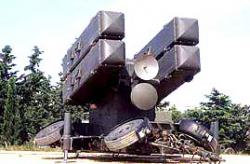
The Skyguard system is powered by a 20 kW (400 Hz frequency) generator driven by an air-cooled petrol engine. There is a voltage regulator. The power unit is located in the unified cabin of the fire control system.
The ZUR launcher, developed jointly with Raytheon, is mounted on the same wheeled carriage as the anti-aircraft artillery unit with 35 mm Oerlikon guns. In its middle part on the turning platform there is an operator's cabin with a target illumination radar and telescope sight. Transport and launch containers with missiles, which are mounted in pairs from the sides of the cabin, are replaced by a truck crane in 5-6 minutes. The PU is controlled by the "Skyguard" system (connected to it by cables) or manually by an operator occupying a place in the cabin.
Sparrow" ASATs of various modifications (AIM-7E, AIM-7F and RIM-7H), as well as "Sky Flash" (Great Britain) and "Aspide-1a" (Italy) missiles created on their basis can be used to engage air targets in this complex. All are equipped with semi-active radar homing heads and a single-stage solid propellant engine.
In 1984-1987, 18 batteries of Skyguard-Sparrow air defense system were delivered to Egypt, which received its own name "Amoun". The battery consists of one Skyguard fire control system. Two twin 35mm towed GDF-003 anti-aircraft guns, two launchers with 4 Sparrow missiles each. The Amoun complex can fire and destroy up to three targets simultaneously: two with missiles and one with cannon means. The reaction time is 4.5 s for anti-aircraft guns and 8 s for missiles. The complexes delivered to Egypt have been upgraded to 16 positions, including a new radar antenna with reduced interference reflections from the ground floor, a new computer and software. The workstations of three operators have been upgraded. The radar target detection range has been increased to 20 km and the optical one to 15 km. In Egypt itself, it was planned to organize the production of individual components of the system.
In Greece, the Skyguard-Sparrow air defense system was named "Velos" and uses the RIM-7M missile.
In Spain, the Skyguard fire control system is combined with the Spada launcher, which hosts the Aspide missiles. Assembly of the Spanish version of the complex, named "Toledo", was carried out in Spain, which also produced a transport and launch container for the missile, separate electronic and mechanical blocks for the launcher.
Characteristics:
| Maximum intercept range, km. | 10 |
| Minimal intercept range, km. | 1.5 |
| Maximum intercept altitude, m | 6000 |
| Minimum intercept height, m. | 15 |
| Maximum effective range of 35 mm Oerlikon machine, km | 4 |
| Oerlikon 35mm gun speed, shot/min (on barrel) | 550 |
| Deployment time of the complex, s | 11 |
| The length of the Sparrow AIM-7E, mm | 3650 |
| The diameter of the rocket body, mm | 200 |
| Wingspan, mm | 1000 |
| Start weight , kg | 205 |
| Weight of shrapnel-flagged combat unit, kg | 30 |
| Maximum missile speed, M | 3.5 |
Testing:
In 1980, the Skyguard-Sparrow showcase was fired at the NATO NAMFI training ground on the island of Crete. A radio-controlled Chukar unmanned target was used as a target. The target flew to the firing position of the complex with the parameter 700 m and had the speed of more than 200 m/s. The first missile hit the target at a range of over 12 km by direct hitting the target. The second target was hit by a non-contact fuse detonating a combat unit, the miss was 1 m.
In mid-1991, the AIM-7F missile was successfully fired, and was directly hit by a radio-controlled target with a speed of over 200 m/s at a range of over 10 km. Later on, a radio-controlled target with supersonic speed was successfully controlled and fired in poor visibility and strong wind conditions.
Sources:
- Викторов В. "ЗРК "Скайгард-Спарроу", Зарубежное военное обозрение,N3, 1982.
- Василин Н.Я., Гуринович А.Л. "Зенитные ракетные комплексы" .-Мн.: ООО "Попурри", 2002- 464с.

